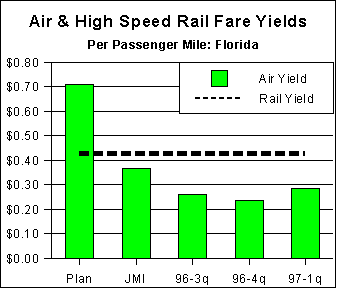
Raise High Speed Rail Subsidy to $18.7 Billion

In April, The James Madison Institute published a
policy report by the Wendell Cox Consultancy
on the proposed Florida high speed rail project (Miami-Orlando-Tampa), which concluded that
the project would provide only neglibible benefits, but its cost to Florida would be enormous.
One of the concerns raised in the James Madison Institute report was that airline fares have
already dropped below the fares that are proposed for the high speed rail system (a difference
of 13.6 percent was estimated).
More recent data, published by the United States Department of Transportation shows that the gap has widened. In the four largest primary air markets that would be served by high speed rail (Miami-Orlando, Miami-Tampa, Fort Lauderdale-Orlando and Fort Lauderdale-Tampa), average airline fares dropped to 32.9 percent below projected high speed rail fares. This reduction has been driven by the increased airline competition in these markets, especially the entry of lower fare airlines, such as Southwest Airlines. Since the high speed rail planning projections were prepared for air fares, average air fares have dropped approximately 60 percent.
High speed rail fares are below air fares only in the Miami-Orlando market. However, Fort Lauderdale International
Airport is close to most of metropolitan Miami and many travelers choose to fly from that facility, which has
lower air fares to Orlando and Tampa. Since the entry of Southwest Airlines into these markets, Fort
Lauderdale's share of south Florida (Miami and Fort Lauderdale) air travel to central Florida (Orlando and Tampa)
has risen from under 50 percent to 77 percent.
Airline fares are so low in relation to proposed high speed rail fares that for high speed rail to meet the price competition would mean charging fares below the cost of debt service on the high speed rail system. The air fare to rail fare comparison is crucial --- for the high speed rail line to attract air passengers, its average fares must be no higher than the average air fare. Air fares have dropped so far that the high speed rail line would be unlikely to cover its fixed costs (capital and debt service) at such fares. Using the model developed for the JMI report, it is projected that matching the air fare structure would require at least $5.9 billion of additional state subsidies, even if present ridership, capital and operating costs were achieved (an eventuality considered highly unlikely). This would raise the "optimistic" subsidy projection (from the JMI report) from $13.8 billion to $18.7 billion --- $15.7 billion more than projected by the Florida Department of Transportation.
| ||||||||||||||||||||||||||||||||||||||||||||||||||||||||||||||||||||||||||
